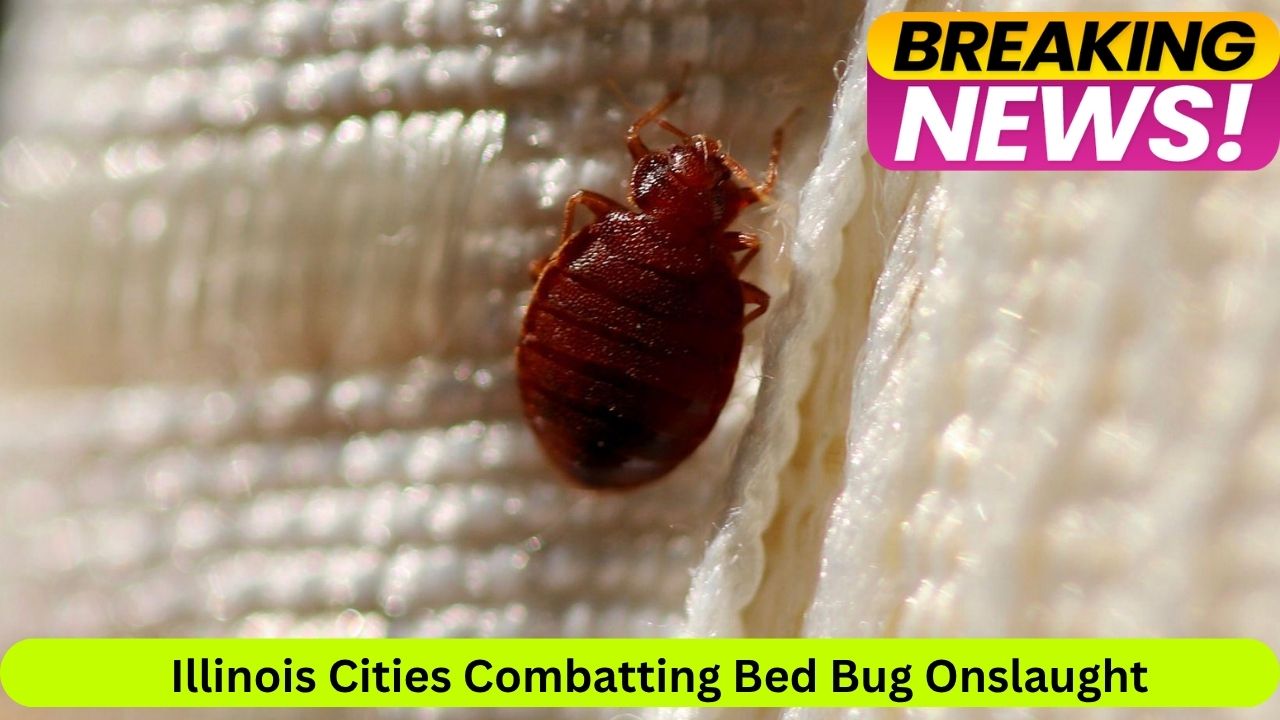Illinois is under siege—not by storms or financial crises, but by something far more sinister and persistent: bed bugs. These tiny, bloodsucking insects have made a disturbing resurgence across the United States, but certain areas of Illinois are particularly hard-hit. What was once seen as a problem confined to cheap motels or poorly managed apartments has become a statewide crisis affecting all income levels, age groups, and neighborhoods.
This blog explores how five cities in Illinois are battling an unrelenting bed bug invasion. From high-rise apartments in Chicago to family homes in Rockford, this infestation has crept into the crevices of daily life, causing both economic and emotional strain. Here’s how these cities are fighting back.
Understanding the Bed Bug Crisis
Bed bugs are small, oval-shaped insects that feed exclusively on blood, mostly at night. They hide in mattresses, furniture, wall cracks, and clothing. Though they do not spread disease, their bites can lead to rashes, allergic reactions, and psychological distress.
One of the biggest challenges in controlling bed bugs is their resilience. They can survive months without feeding and often go unnoticed until the infestation becomes severe. Their tiny size allows them to travel easily between apartments, hotels, and homes, making them a true urban parasite.
The rise in global travel, second-hand furniture sales, and inadequate pest control policies have all contributed to the rapid spread of these pests.
Why Illinois is a Hotspot for Bed Bugs
Illinois, with its high urban population density, cold winters that push people indoors, and economic disparity in certain cities, creates a perfect environment for bed bugs to thrive. Public transportation, tightly packed housing units, and high tenant turnover rates are all contributing factors.
Another major problem is the lack of uniform pest control regulations across municipalities. While some cities have robust programs, others struggle with underfunded health departments and limited tenant protections.
The Top 5 Most Affected Illinois Cities
Chicago
As Illinois’ largest city, Chicago unfortunately also holds the title of being one of the top U.S. cities for bed bug infestations. For several consecutive years, Chicago has ranked in the top three for the highest number of bed bug reports in the country.
Why the outbreak?
-
High-rise apartment buildings allow rapid bed bug transmission.
-
Public transport systems are another risk factor—bed bugs can hitch a ride on clothing and luggage.
-
The large number of hotels, hostels, and Airbnb rentals make Chicago a hub for insect transmission.
Local Response
The city has implemented public awareness campaigns, including free workshops and online educational tools. Some aldermen have proposed legislation mandating landlords to report infestations and take prompt action, although enforcement remains inconsistent.
Resident Experience
Many Chicagoans have resorted to using expensive private pest control services. Others face delays from landlords and even evictions after reporting infestations.
Rockford
Rockford has seen a troubling increase in bed bug complaints over the past few years. Once limited to low-income neighborhoods, infestations are now common in middle-class homes and even commercial offices.
Why Rockford?
-
Aging infrastructure makes it easy for bugs to find hiding places.
-
A high number of rental properties with limited pest control budgets.
-
Poor landlord accountability contributes to the issue spreading quickly.
Response Strategy
Rockford’s public health department has issued new guidelines for landlords and tenants. Local schools have even adopted temporary closures and inspections after bed bugs were found in backpacks and lockers.
Community Action
Nonprofits have begun offering low-cost bed bug treatments and mattress encasements. There’s also been a push for tenant rights education to help renters know what steps to take.
Peoria
Peoria has witnessed a quiet but concerning growth in bed bug activity. With many older apartment complexes and public housing units, infestations can spread quickly and become difficult to control.
Contributing Factors
-
Limited public resources for pest control.
-
Lack of tenant education on how to prevent and manage outbreaks.
-
Increase in second-hand furniture purchases due to economic conditions.
Mitigation Efforts
Peoria has initiated joint inspections between public housing authorities and pest control experts. The city is also developing a reporting portal for residents to alert health authorities.
Resident Experiences
Many residents report spending thousands on exterminators, often with limited success. The emotional toll has also been high, with some even discarding furniture and belongings entirely.
Springfield
The state capital is not immune to the bed bug crisis. Springfield has experienced a steady rise in bed bug infestations across residential neighborhoods and state-run facilities.
Challenges in Springfield
-
Government buildings have reported recurring infestations.
-
Senior housing complexes are particularly vulnerable.
-
Limited outreach and education for low-income families.
Policy-Level Response
Springfield has begun to include bed bug inspections in routine health checks for housing units. Officials have also introduced a hotline where residents can report infestations anonymously.
Community Feedback
There has been frustration with the slow response time. However, recent grants from the Illinois Department of Public Health aim to increase capacity for fast response teams.
East St. Louis
East St. Louis faces unique challenges when it comes to pest control, including underfunded public services and deteriorating housing infrastructure. Bed bugs are now considered one of the top residential complaints in the city.
Why So Bad Here?
-
High poverty rates make it difficult for residents to afford professional pest control.
-
Dilapidated housing makes it nearly impossible to completely eliminate infestations.
-
Some landlords are absent or uncooperative in handling complaints.
What’s Being Done?
Grassroots organizations have taken the lead, offering free bed bug kits and inspection services. The city is also working on new tenant protection ordinances to force landlords into compliance.
Community Stories
Many residents recount horror stories of repeated infestations and landlords refusing to act. Some families have moved multiple times within the city, only to encounter the same problem elsewhere.
Health Risks and Psychological Impact
While bed bugs are not known to transmit disease, the physical and mental effects are severe:
-
Allergic Reactions: Some individuals develop severe skin reactions, requiring medical attention.
-
Sleep Deprivation: Constant fear of being bitten leads to insomnia.
-
Anxiety and Depression: Long-term infestations are linked to increased stress, anxiety, and social isolation.
-
Stigma: Many victims feel ashamed and avoid inviting people over, leading to loneliness and a deteriorated quality of life.
Economic Impact on Residents and Cities
The cost of a bed bug infestation can be staggering:
-
Residents: Individual households may spend between $500 to $3,000 on extermination, new furniture, and temporary housing.
-
Landlords: Legal fees, property damage, and tenant relocation costs can accumulate quickly.
-
Cities: Health departments bear administrative burdens from complaints, inspections, and litigation.
Additionally, tourism and hospitality sectors may suffer. Hotel reviews citing bed bugs can cause lasting damage to reputation and revenue.
Local Government and Community Responses
City councils and health departments across Illinois are stepping up:
-
Policy Changes: Several cities have introduced legislation requiring quicker landlord response times and mandatory reporting.
-
Education Campaigns: Flyers, social media posts, and workshops help teach residents how to detect and prevent infestations.
-
Grant Programs: Some municipalities now offer financial assistance to cover extermination costs for low-income families.
Yet, many residents argue that these efforts are insufficient or come too late. Stronger enforcement and more proactive education are needed.
How Residents Are Fighting Back
Illinois residents have become warriors in this silent battle:
-
DIY Methods: Use of heat treatment, essential oils, and vacuum sealing mattresses.
-
Community Groups: Social media groups now serve as hubs for sharing tips and contractor recommendations.
-
Tenant Advocacy: Some neighborhoods are forming tenant unions to demand accountability from property owners.
These grassroots efforts have begun to make a noticeable difference in some communities, but they need broader institutional support.
Future Projections and Preventive Measures
Experts believe the bed bug problem is unlikely to disappear soon. However, smarter strategies can reduce outbreaks:
-
Integrated Pest Management (IPM): A combination of monitoring, education, and safe pesticide use.
-
Legislation: Stronger statewide laws on pest control obligations and tenant protections.
-
Innovation: Heat chambers, scent detection dogs, and new non-toxic chemical treatments show promise.
-
Awareness: Early detection through education and regular inspections is the most effective tool.
As Illinois prepares for another hot summer—peak bed bug season—residents and officials alike must remain vigilant.
Conclusion
The bed bug crisis in Illinois is a stark reminder that even small pests can cause big problems. In cities like Chicago, Rockford, Peoria, Springfield, and East St. Louis, residents are fighting a war that’s as much about awareness and action as it is about extermination. While some progress has been made through education and policy changes, the road ahead requires a united effort.
The battle isn’t just against insects—it’s against stigma, misinformation, and inaction. And until a comprehensive, statewide strategy is in place, the invasion will continue.
















Leave a Reply